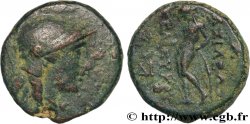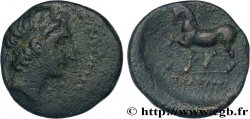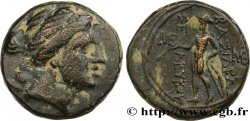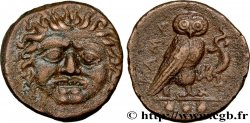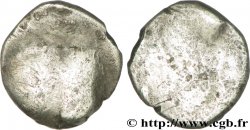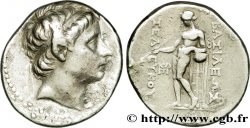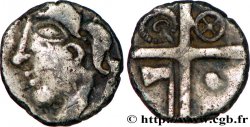MONNAIES 38 (2009)
Starting price : 300.00 €
Estimate : 550.00 €
unsold lot
Starting price : 300.00 €
Estimate : 550.00 €
unsold lot
Type : Tétradrachme
Date: c. 244-240 ou 240-230 AC.
Mint name / Town : Syrie ou Mésopotamie
Metal : silver
Diameter : 28,5 mm
Orientation dies : 12 h.
Weight : 16,72 g.
Rarity : R2
Coments on the condition:
Exemplaire sur un flan large, légèrement décentré au droit, mais parfaitement centré au revers. Beau portrait de style fin et racé à l’usure régulière. Joli revers bien frappé. Usure importante, mais parfaitement lisible et identifiable
Catalogue references :
Obverse
Obverse legend : ANÉPIGRAPHE.
Obverse description : Tête diadémée de Séleucus II à droite ; grènetis circulaire.
Reverse
Reverse description : Apollon, nu debout à gauche appuyé sur un trépied, tenant une flèche de la main droite ; dans le champ à gauche, un monogramme.
Reverse legend : BASILEWS/ SEL-EUKOU/ (MWTR)
Reverse translation : (du roi Séleucus).
Commentary
Cet exemplaire présente plusieurs accidents au droit sur la tête au-dessus de l’oreille et sur le bandeau du roi (coin bouché) et au revers, devant la pointe de la flèche dans le champ à gauche et dans le champ à droite à la base du nom du roi (cassures). Georges Le Rider pour cette série particulière qui n’est pas forcément de l’atelier d’Antioche avec notre monogramme dans le champ intérieur, l’auteur a recensé six exemplaires avec deux coins de droit et cinq coins de revers. Notre exemplaire semble de même coin de droit.
This example has several accidents on the obverse on the head above the ear and on the king's headband (blocked corner) and on the reverse, in front of the arrowhead in the left field and in the right field at the base of the king's name (breaks). Georges Le Rider for this particular series which is not necessarily from the Antioch workshop with our monogram in the inner field, the author has listed six examples with two obverse corners and five reverse dies. Our example seems to have the same obverse corner
This example has several accidents on the obverse on the head above the ear and on the king's headband (blocked corner) and on the reverse, in front of the arrowhead in the left field and in the right field at the base of the king's name (breaks). Georges Le Rider for this particular series which is not necessarily from the Antioch workshop with our monogram in the inner field, the author has listed six examples with two obverse corners and five reverse dies. Our example seems to have the same obverse corner








 Report a mistake
Report a mistake Print the page
Print the page Share my selection
Share my selection Ask a question
Ask a question Consign / sell
Consign / sell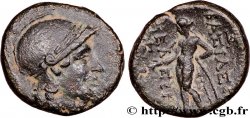
 Full data
Full data